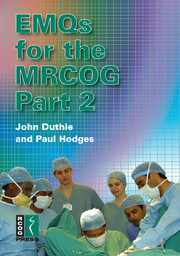Book contents
- Frontmatter
- Contents
- Preface
- Acknowledgements
- Abbreviations
- Foreword
- How to use this book
- 1 The educational and evaluative benefits of EMQs
- 2 EMQ answering technique
- 3 Worked examples
- 4 Mock examination 1
- 5 Mock examination 2
- 6 Mock examination 1 answers
- 7 Mock examination 2 answers
- Appendix 1 Mock examinations answer keys
- Appendix 2 Mock examinations answer sheet (blank)
- Index
How to use this book
Published online by Cambridge University Press: 05 July 2014
- Frontmatter
- Contents
- Preface
- Acknowledgements
- Abbreviations
- Foreword
- How to use this book
- 1 The educational and evaluative benefits of EMQs
- 2 EMQ answering technique
- 3 Worked examples
- 4 Mock examination 1
- 5 Mock examination 2
- 6 Mock examination 1 answers
- 7 Mock examination 2 answers
- Appendix 1 Mock examinations answer keys
- Appendix 2 Mock examinations answer sheet (blank)
- Index
Summary
The first two chapters provide some background and an introduction to the new format and will help you to decide how best to approach this examination. The next chapter, Chapter 3, provides worked examples of specimen EMQs with answers and a brief explanation. In total, there are 15 lists of options and 62 twigs (over one paper's worth). There is also some advice on how to tackle each EMQ and how to avoid mistakes.
Chapter 4 is composed of EMQs printed without answers. There are 16 lists of options, producing a total of 40 items. This particular chapter is an example of exactly what candidates will face in the written paper of the Part 2 examination leading to Membership of the Royal College of Obstetricians and Gynaecologists. To make it an exact replica of the examination to be faced, you should recreate examination conditions as best as you can (at the very least, make sure you cannot be disturbed at all) and time yourself tackling it – under an hour should be your target. Many, but not all, of the option lists will be familiar from the worked examples – however, all of the twigs are different.
Chapter 5 is another mock paper. There are ten option lists, again producing a total of 40 questions. This is totally fresh. The option lists from the worked examples are not included (six option lists which were used new for the first mock paper are repeated but again have fresh twigs). This paper should provide you with an even more realistic trial of what the new EMQ Part 2 paper will be like.
Information
- Type
- Chapter
- Information
- EMQs for the MRCOG Part 2 , pp. xiii - xivPublisher: Cambridge University PressPrint publication year: 2006
